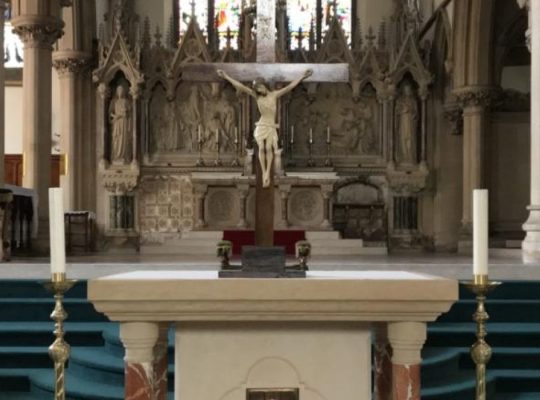In all ages there have been diseases that inspire fear and strike the imagination because of the mysterious character of their appearance and spread and of our inability to find a remedy for them. If, moreover, they cause disfiguring lesions or noticeable deformities, they arouse revulsion. People dare not look at the persons stricken with such sickness, and still less they want no contact with them; they avoid them. Whether justified or not, the fear of contagion results in isolation of the sick. Such was the case for leprosy for a long time, singularly in the Near East. When religious concepts link health and holiness, sickness and sin, those who are stricken with a mysterious and incurable ailment are readily considered to be undergoing divine punishment. We do not have here a merely archaic conception of religion, of temporal retribution and, as a consequence of the meaning of adversities that befall individuals and entire populations. Whatever the degree of sophistication of religious thought, the problem of suffering—death—remains. What meaning can misfortune and disease have? Where do calamities such as disastrous epidemic, sudden endemic, come from? Are they not always blamed in some way on sins, understood either in the strict personal sense or in the wide sense of faults committed, voluntary or not, by human beings? Leviticus does not ask these questions in so many words, but it promulgates laws of prophylaxis regarding leprosy. Today’s First Reading reminds us of these because the Gospel depicts the cure of a leper by Jesus, and because this cure is fully understood only in reference to the manner in which lepers were regarded and treated.
Lepers were unclean, but not only by reason of their diseased skin. They were to ‘dwell apart…. outside the camp,’ but not only for fear of contagion. Their lesions evoked memories of those festering boils that had afflicted the Egyptians and their cattle. These were punishments in retribution for Pharaoh’s hardening his heart and opposing God’s will. The Israelites were spared. But recalling the evils befalling the Egyptians. Deuteronomy says the same would strike God’s people if they were unfaithful to the Lord’s law. (Deut 28:21,27,35). Moreover, the Book of Isaiah envisions the whole people as a single person seriously ill for having repeatedly broken the covenant. However, a mysterious Servant of God will arise, a Just One who will take upon himself the sins and the sufferings of the multitude. ‘By his stripes’ all will be healed. God has heard him interceding for human beings stricken with the leprosy of sin, now assured that their cries of distress will be heard. ‘If you want to, you can cure me.’
As a way of ending the general presentation of Jesus’ ministry, Mark depicts for his readers a truly extraordinary scene of healing, echoing the promise made in the Book of Isaiah of the manifestation of a mysterious Servant of God. For the healing Mark talks about is not just any sort of disease, as feared as any disease might be, but leprosy, which rendered those it affected unclean, excluded from society and from participation in worship. Jesus allows this leper to come to him. He cleanses him with a word, while touching him with his hand. He then gives a stern warning to the man he has just cured, this surprises us and we do not know what to make of it. The man, for his part, does exactly the opposite of what he was told: he broadcasts to all and sundry what has just happened to him. Jesus appears much annoyed by this, and as suspected, he does not succeed in escaping the crowds that managed to find him and leave him no peace. Every one of the elements in this picture must hold our attention because they no doubt contain teachings that Mark wants us to discover first of all, alert to us to this, he inserts such a narrative at this point; he abruptly launches into it without any historical or geographical context. All this throws the story into striking relief and suggests that it has a particular meaning in Mark’s Gospel.
‘A leper came to him.’ This action, which defies all the interdictions, is scarcely believable. We do not see how the leper was able to approach Jesus without being restrained by those who saw him coming; they should have shouted in order to chase him far away. But Mark says nothing about this; he does not even mention witnesses, as if Jesus’ companions, present up to now, have vanished. ‘A leper came,’ was able to come, ‘to him.’ All barriers are down. All lepers must know this as well as those who keep them apart from everything and everyone. Whoever believes that Jesus, if he so wishes, can purify them, let them draw near and rely upon the Lord’s kindness. From the beginning of his Gospel Mark has shown that Jesus’ teaching, his power over evil spirits and disease manifests his authority. This is precisely what manifests the attention of the multitudes to Jesus. By emphasizing this authority, Mark urges us to follow Jesus on the roads where he announces the good news. However, the way Jesus exercises this sovereign authority during the day at Capernaum may appear somewhat cold and remote. Jesus seems to put his power at the service of the sick, while remaining impassive. The cure of the leper convinces us to go beyond this first impression: Jesus is ‘moved with pity.’ In current usage, ‘pity’ belongs to the realm of feeling; it is ‘sympathy with the grief or misery of another; compassion or fellow suffering,’ There is a connotation of condescension. The Bible does not give this meaning to pity or mercy, but speaks of them as powerful feelings, made of tenderness and love, gut wrenching and producing acts that relieve and heal those who inspire them. Such is Jesus’s pity.
‘Of course I want to….Be cured.’ As the Roman centurion had proclaimed: ‘Only say the word and my servant will be healed,’ these words would be sufficient, as were the words, ‘Come out of him!’ To deliver the demoniac at Capernaum from the evil spirit. But the Lord ‘stretched out his hand’ and touched the leper. This gesture, accompanying the word, concretely illustrates the pity of Jesus, whose compassion for the one who is imploring him with trust is not a remote sort of thing. Christians cannot help but invoke the laying on of hands, the unctions that, along with words and prayers constitute sacramental rites. When reading this account, we could even think of what happens in the sacramental encounter with the Lord. Faith impels us to ask that he use his healing power: ‘If you want to, you can heal me.’ The sacrament is the answer to this expectation and the seal that authenticates faith. ‘Jesus confirms and corroborates what the leper had said; and consequently, he does not merely answer ‘Be cured.’’ By speaking in this manner, he verifies the truth glimpsed by the man and confirms the leper’s own statement. What follows is the more surprising. ‘Then, warning him sternly, he dismissed him at once. Then he said to him: ‘see that you tell no one anything, but go, show yourself to the priest and offer for your cleansing what Moses prescribed, that will be proof for them.’’ We can understand the command to go and submit to the official examination by the priests charged with the duty, according to the manner prescribed by the Law. It was in the man’s interest to have the cure verified in due form and thus to be officially reintegrated into the community.
If Jesus had been content with reminding him of this obligation, fearing that in his joy the man might forget to fulfil it, we could see in Jesus’ command a mark of delicacy. But Jesus speaks in strongly threatening tones. What is going on? Obviously, Jesus wants the leper to leave as fast as possible, as if the man was an embarrassing witness whom Jesus wants to disappear and melt into the anonymous crowd. For lack of an explanation on Mark’s part, we can only refer to the fact that he mentions several times a similar command to keep silent. At the time of Mark’s writing, the good news, far from being kept a secret, is publicly proclaimed from the rooftops, according to the Lord’s command. But Mark is keen on progressive pedagogy. We must respect the steps in Christian initiation lest the Lord’s true identity and meaning of his mission be misunderstood. He is not a healer or exorcist among others, even though endowed with unheard of powers. He is Saviour, who gave his life to heal humankind from the disease of sin, evoked at the time by leprosy more than any other illness. There would be a grave equivocation if we were mistaken about the meaning of the healings he performed.
But the healed leper cannot contain his joy: ‘The man went away and began to publicize the whole matter. He spread the report abroad…..’ Jesus then tries to escape the crowds and their infatuation. He enters towns on the sly, he even avoids inhabited places, but to no avail, people come to him from everywhere. His peacefully begun mission is going to take a completely different turn.
It is impossible to live in the world without being exposed to its chaotic and unyielding nature. There are no desert places to spare us its contact. Having assumed human nature in its totality, Jesus experiences this from the outset of his ministry. Since the crowds come to him, he goes to them, to reveal his true self, inopportunely proclaiming his title Son of God, demons are seeking to discredit him, but Jesus silences them in turn, but he will not, however, escape their constant assaults and this war of attrition. He will emerge victorious but only on the cross, when a pagan, seeing ‘how he breathed his last’ will cry out in an act of wholehearted faith, ‘Truly this man was the Son of God.’
‘A great prophet has appeared among us; God has visited his people. Alleluia .’


